Abstract
The integration of social intelligence mining with Large Language Models (LLMs) and unstructured social data can enhance land management by incorporating human behavior, social trends, and collective decision-making. This study investigates the role of social intelligence—derived from social media—in enhancing land use, urban planning, and environmental policy crafting. To map the structure of public concerns, a new algorithm is proposed based on contextual analysis and LLMs. The proposed method, along with public discussion analysis, is applied to posts on the X-platform (formerly Twitter) to extract public perception on issues related to land use, urban planning, and environmental policies. Results show that the proposed method can effectively extract public concerns and different perspectives of public discussion. This case study illustrates how social intelligence mining can be employed to support policymakers when used with caution. The cautionary conditions in the use of these methods are discussed in more detail.
1. Introduction
Land management is a critical domain that shapes environmental sustainability, urban development, and resource allocation [1]. Traditionally, decision-making in this field has relied on structured data sources, such as satellite imagery, geographic information systems (GIS), and census records [2,3]. These physical characteristic-based approaches often overlook the dynamic nature of human behavior, social interactions, and collective decision-making processes, which play a pivotal role in shaping land use patterns [4,5,6]. The advent of social intelligence mining—harnessing insights from social media, participatory platforms, and crowdsourced data—presents a transformative opportunity to bridge this gap [1,7,8].
Recent advancements in artificial intelligence (AI), particularly deep learning and natural language processing (NLP), have enabled the extraction of meaningful patterns from vast, unstructured datasets generated by human activities [9,10,11]. AI-based methods have been applied to structured data sources to support land use and urban planning. Examples include water supply management using Geo-AI [12], land change studies [13,14], and cropland and agricultural planning [15,16,17]. By integrating these technologies with traditional land management frameworks, policymakers and urban planners can gain insights into public sentiment, emerging trends, and localized environmental concerns. This synergy between AI-driven analytics and human-centric data can enhance decision-making processes in areas such as land use planning, environmental monitoring, and disaster risk management [18].
Urban development and land use plans and policies have socio-economic impacts [19,20]. Changes in land planning can affect economic growth, social justice, and environmental conditions [19]. All of these changes will reflect on society’s wellbeing and, in turn, shape public perception of these plans and policies.
Studies have indicated that public perception of an issue significantly impacts how society will accept, collaborate, or participate in the plans and policies addressing that issue [21]. For instance, if these policies do not consider people’s wellbeing and immediate concerns, negative public perception might result in reduced communities’ collaboration and engagement in implementing such plans and policies [5,21]. Many future potential issues in urban planning and land use policies are part of today’s public concerns and discussions [22,23]. If such concerns are not considered in the development of urban planning and land use policies, addressing the undesired outcomes in the future will incur more costs and likely necessitate changes in the adopted policies. As such, understanding public perception and concerns regarding urban planning and land use policies is essential for crafting sustainable policies. Additionally, analyzing public discussions around urban planning and land use reveals issues that people are observing and experiencing before they are detected by authorities [22]. In this case, a clear image of public discussion can help authorities detect these issues in early stages.
Insights from public discussions and concerns related to land use policies and urban planning either present a valid issue or represent concerns that are not rooted in the real consequences of adopted policies and plans [24]. Either way, they provide policymakers and decision-makers with the existing public perception. If public concerns are valid, they can be used to collaborate with community representatives for the co-design of policies and plans [25]. If the concerns and issues expressed in public discussions do not have roots in the reality of adopted plans and policies, this insight can be used to design social outreach solutions to support those policies [24].
As explained above, crafting sustainable urban planning and land use policies requires a clear understanding of public perception, public discussions, and people’s concerns about issues related to urban planning and land use policies. One common way to understand public perception and discussion is through surveys. However, since surveys have a structured format, they can only collect data on issues already known to the survey designer (see [21,26,27] for example). An alternative approach to surveys is analyzing social media data [22,23]. Discussions, concerns, and opinions expressed on social media represent part of the public perception on a given topic. Through real-world social networks and small communities, these discussions connect to other parts of public discussion [28,29]. Insights from social media not only shed light on a segment of public opinion but also interact with other societal elements. Furthermore, coupling this information with other insights (e.g., from interviews or community engagement activities) can create a more detailed image of public perception [30]. While analyzing social media textual data is challenging, it provides insight into ongoing public discussions and issues [1,7,8,31]. Social intelligence mining methods are developed to extract these insights from unstructured social media textual data [1,7,8].
This paper explores the role of social intelligence mining in transforming land management practices. We analyze case studies where AI-powered social data analysis has contributed to equitable land distribution, urban resilience, and sustainable resource management. By highlighting the potential of this interdisciplinary approach, we demonstrate how integrating social intelligence with deep learning can address contemporary land management challenges and foster more inclusive, adaptive, and data-driven policies.
The remainder of this paper is structured as follows: Section 2 presents AI-based methods for extracting social intelligence from social media, including public discussion analysis and concern mapping. Section 3 provides the results of applying these methods to real-world data, analyzing public discourse on land management and sustainability. Section 4 discusses the implications of our findings for policymaking and land use planning and concludes with key takeaways and future research directions.
2. AI-Based Methods for Mining Society’s Intelligence Through Social Media Posts
2.1. Public Discussion Analysis
Public discussion refers to a collection of society’s public narratives, public opinions, and the public exchange of opinions and statements among people around a topic. It includes the opinions publicly expressed by one part of society and the replies and comments from another part. This exchange is not necessarily person-to-person but is context-oriented. In other words, the reaction to opinions is more focused on the context of the opinion rather than on who shared it first.
Due to the context-oriented nature of interactions in public discussions, the usual methods for analyzing social network connections (among people) would not reveal the structure of the public discussion.
Hassani et al. [7] proposed the public discussion analysis method, PDA, to analyze the public discussion around a topic. Their method uses NLP to extract the key phrases from the batch of social media posts related to that topic. These key phrases and their linkage show the context and structure of the discussion in those social media posts.
This PDA method uses network linkage clustering to extract highly connected sub-networks from the key phrase network and uses that to identify the sub-discussions within that topic. These sub-discussions reveal the different aspects of the topic being discussed by people. Figure 1 shows the steps in the PDA method.

Figure 1.
PDA conceptual model [7].
The PDA method not only uses NLP for key phrase extraction but also uses LLMs to extract and summarize the narratives in different subsets of the public discussion.
2.2. Concerns Map
As mentioned before, any sustainable planning needs to consider and address society’s existing concerns. The classic approach to understanding those concerns involves running surveys about issues raised by community representatives or through public activities. However, these surveys cannot capture all public concerns. One reason is that such surveys are only effective if the concern is raised by community representatives or experts with access to media and policymakers or through community activities. Concerns discussed publicly but not included in the above-mentioned narratives will go unnoticed. Furthermore, it usually takes time for the concerns to be raised and for the survey results to become available. As such, the survey results do not reflect the immediate and up-to-date situation of issues in society. Another reason is that surveys do not include everyone, and some communities might be left out. Additionally, people might not share their true opinions about a given concern.
Extracting concerns from social media posts can provide real-time insights into public concerns. Clearly, the concerns expressed on social media do not represent everyone in society, as not everyone shares their concerns on these platforms. However, these concerns can significantly impact public discussions beyond social media. Furthermore, combining this information with data on social media usage can offer a clearer picture of societal issues.
Komendantova et al. [1] proposed a public concerns detection (PCD) method to extract public concerns and proposed solutions regarding a given topic from social media posts. Their method uses an LLM to extract concerns and their related proposed solutions from each social media post. In the next stage, the model categorizes the topics of concerns and solutions. The concerns and their connected solutions are then used to build the adjacency matrix for the concern–solution contextual map. The steps in their PCD method are shown in Figure 2.
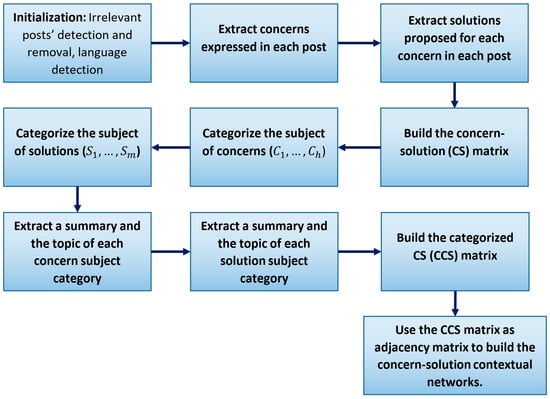
Figure 2.
PCD conceptual model [1].
The categorization method used in [1] was based on building a similarity matrix for the extracted concerns and solutions. While this method provides more accurate results by comparing the similarity of each pair of concerns and each pair of solutions, it is not very time-efficient. Furthermore, the final map only connects the concern categories through their related solution categories. As such, the final map only presents the relationship between the concerns and the solutions, even if multiple solution categories are connected to one concern category and vice versa.
2.2.1. Concern Topic Categorization Using LLM
To increase the time efficiency of the topic categorization algorithm, this research proposes the following Batch Topic Categorization with LLM (BTC-LLM) algorithm:
- BTC-LLM Algorithm:
- Create the “Instructions Set 1” to extract the concern-topic categories from a given batch of concerns.
- Create the “Instructions Set 2” to check each of the concerns in the batch with the given list of concern-topic categories. If the individual concern does not fall into any of the given categories, add a new concern-topic category to the list.
- Divide the list of concerns into batches (based on the character limit for requests in the LLM). Suppose there are “” batches of concerns: .
- Send the “Instruction Set 1” and to the language model and get the preliminary list of the concern-topic categories; suppose is the preliminary list of the concern-topic categories.
- For each batch (), feed , , and “Instruction set 2” into the language model to produce the updated list of concern-topic category, .
- Repeat Step 5 times to ensure convergence.
- The final list of concern-topic categories will be .
It should be noted that, since the LLM and NLP models are stochastic models, the result of two runs of the model with the same input data might be different. As such, different runs of Steps 4 and 5 might produce different s. The sequential design of the algorithm (the list generated in each iteration will be fed to the next iteration) and the iteration in Step 6 make it possible to control the stochasticity by refining the list of categories to reach convergence ( stays the same for a number of iterations). The larger number of iterations, , will increase the chance of reaching convergence.
The BTC-LLM algorithm is proposed for exploratory topic modeling, leveraging the context and semantics of the texts. Additionally, the precision of the results can be adjusted by increasing the number of iterations. One commonly used method for exploratory topic modeling based on textual context and semantics is BERTopic [32]. However, it does not generate context-based descriptions of topic categories; instead, it uses frequent keywords as topic labels.
2.2.2. Concern-Topic Categories’ Linkage
Once the concern-topic categories are extracted, they can be linked to each other based on the concerns in each category.
Suppose the topics of concern are categorized as ( is the total number of the concerns extracted from social media posts, and is the number of categories identified in the BTC algorithm). Since each individual concern can belong to different topics, the shared concerns between concern-topic categories show the linkage between them. The larger the number of shared concerns between two concern categories, the closer their context is related. This definition of the linkage between the concern-topic categories can illustrate the relation between the context of the concern categories. Furthermore, it is quantifiable and can be used to build the adjacency matrix for the Concern-Topic Categories Contextual Network, CTCCN. Suppose Concern-Topic Categories Linkage, is defined as the number of concerns shared with categories and :
where is the indicator function, i.e., if Concern is in concern-topic category and otherwise. With this definition of concerns’ linkage, the adjacency matrix for will be as follows:
3. Results
In this study, the public narrative and discussion on “X” (formerly Twitter) around “Land Management”, “Sustainability”, “Social Trends”, “Environmental Monitoring”, and “Disaster Risk Management” is analyzed.
The related English language posts between 8 December 2024 13:30 and 15 December 2024 12:30 are collected with the following list of keywords: “City Planning”, “Urban Planning”, “Farming”, “Gardening”, “Land use”, “Land planning”, “Waste”, “Eco Friendly”, “Global Warming”, “Climate Change”, “Eco-Friendly”, “Pollution”, “Clean Water”, “Protecting Wildlife”, “Saving Forest”, “Air Quality”, “Health Trends”, “Sustainabl”, “Technology Adoption”, and “Cultural Change”. After cleaning the collected posts (removing the unrelated posts based on unrelated hashtags and keywords), there were 3076 X posts during that time period. Since the focus of this study is the context of public discussions, in order to maintain users’ privacy, all the posts are anonymized by removing the X user names. Figure 3 shows the regional distribution of extracted posts based on the authors’ location (the location authors shared publicly as their location or country on their X platform accounts). The authors of 828 tweets did not shared this information publicly.
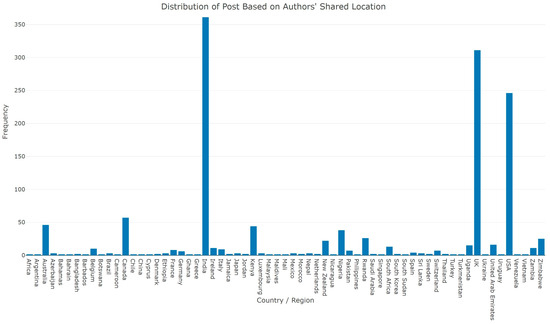
Figure 3.
Regional distribution of extracted post, based on authors’ publicly shared region/country.
As can be seen in Figure 3, most of the tweets are posted by users from the US, the UK, and India. It should be noted that these countries are not necessarily the locations from which the posts were sent.
The key phrases of these posts are extracted using Azure text analysis module, free tire, as explained in [1,7,8]. This module uses a variety of language models like BERT [33], ALBERT [34], and GloVe [35]. Using the Azure text analysis module, the sentiment of each post is also estimated. Figure 4 shows the distribution of sentiment among the analyzed posts and the most frequent key phrases in each set of posts.

Figure 4.
Distribution of sentiment among the analyzed posts and the most frequent key phrases in each set of posts.
As it can be seen in Figure 4, there are shared key phrases among the positive (Figure 4C), negative (Figure 4B), and neutral sentiment posts (Figure 4D) which suggest the topics are being discussed form different aspects. Figure 4E shows that most of the posts have neutral sentiment. However, according to Figure 4A, the most frequent keywords are not dominated by frequent words from neutral sentiment posts. Furthermore, there are some keywords unrelated to environmental issues, which shows the metaphorical use of some phrases. These phrases will be deprecated in topic categorization (BTC-LLM algorithm), as they have different topics and do not represent environmental concerns.
The PDA is applied on the posts to extract the X users’ discussion structure around above-mentioned keywords in the above-mentioned time period. The key phrase network has 94,491 edges. The 1% most frequent edges are shown in Figure 5. It should be noted that frequency of edge between two key-phrases show the frequency of those key-phrase appearing in the same post. The 1% most frequent edges represent the 91.6% of the analyzed posts.
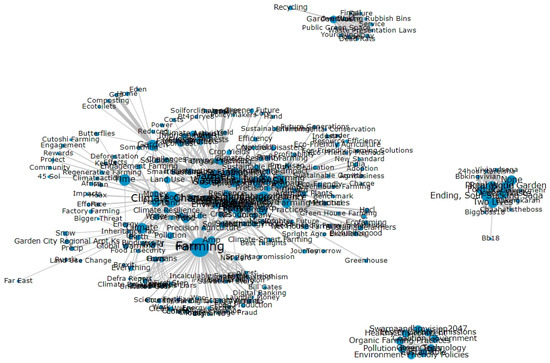
Figure 5.
Key phrase network with the 1% most frequent edges from 94,491 edges.
As can be seen in Figure 5, among the 1% most frequent linked key phrases, there are isolated sub-networks, indicating stronger contextual connection among some key phrases. However, it should be noted that the network is showing 1% of the most frequent edges, and the isolated parts will become connected once more edges are included in the network. The details of different sub-networks of Figure 5 are presented in Figure 6.

Figure 6.
Details of different sub-networks of Figure 5.
Figure 6 shows that the majority of the connected contexts in the post are related to “Climate change”, Waste, “Farming and Farmers”, and “SAL” (Spright Agro Limited). However, the key concepts in the isolated sub-networks are different. One of the isolated sub-networks (shown in the middle-left panel of Figure 6) represents the discussion around the waste management issues. Another isolated sub-network (shown in the middle-right panel of Figure 6) represents the context which used the waste and garden related phrases metaphorically. Another isolated sub-network (shown in the bottom panel of Figure 6) shows key phrases related to sustainable planning, although the only specific example discussed is “Swarnandhra Vision 2047”. The thinness of the edges and smaller node size shows less frequent key phrases and less frequent key phrase connections. The key phrase network from posts with positive sentiments is presented in Figure 7 along with the details of the sub-networks.
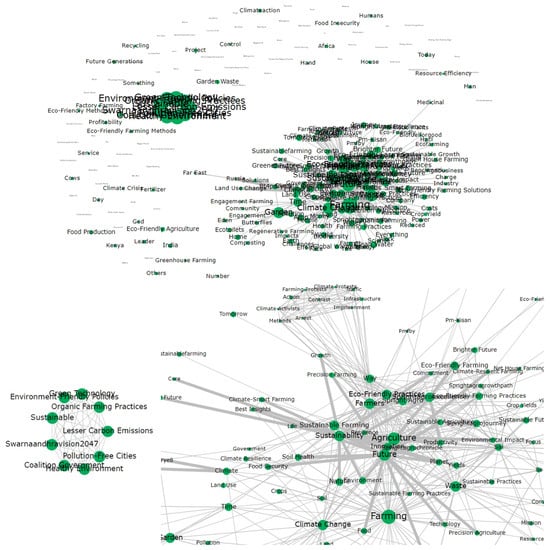
Figure 7.
Key phrase network from posts with positive sentiments and the details of the sub-networks.
As can be seen in Figure 7, the sub-networks related to sustainable planning. The sub-networks from context with “metaphorical use of waste” and “waste management issues” are not in among the positive sentiment contexts. The key phrase network from posts with negative sentiments is presented in Figure 8 along with the details of the sub-networks.
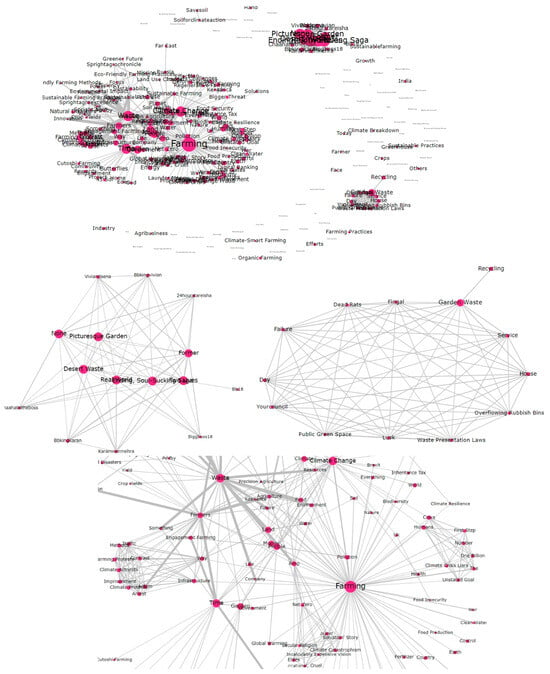
Figure 8.
Key phrase network from posts with negative sentiments and the details of the sub-networks.
Figure 8 shows that the context from negative sentiment posts does not include sustainable planning key phrases. However, the metaphorical use of environmental key phrases and the discussion around waste management are falling in this context. The key phrase network from posts with neutral sentiments and details of its sub-networks are presented in Figure 9.
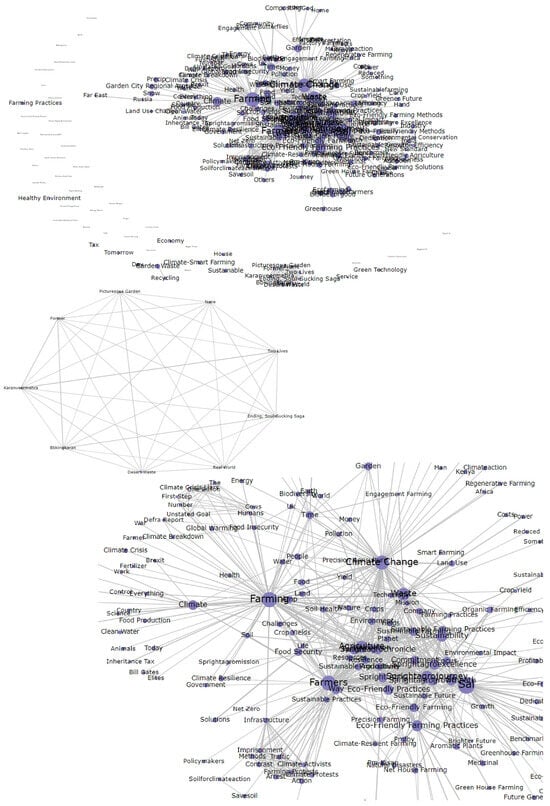
Figure 9.
Key phrase network from posts with neutral sentiments and the details of the sub-networks.
As shown in Figure 9, many of the key phrases from natural sentiment posts are similar to positive sentiment and negative sentiment posts. However, the connections and the frequencies (thickness of the edges and the size of the nodes) are different. Figure 7, Figure 8 and Figure 9 show that even when there are frequent key phrases shared among different sentiments, the linkage between them is not the same. The main topics of the posts with different sentiment groups are given in Table 1 (see the extended summaries of posts in Appendix A.1).

Table 1.
Main topics of the posts with different sentiment groups.
As can be seen in Table 1 and Appendix A.1, the negative sentiment posts include complaints and concerns. A large summary of the neutral sentiment posts shows the large diversity among these posts. This includes statements and reports. Following the steps of PDA, the cluster analysis result is given in Figure 10.
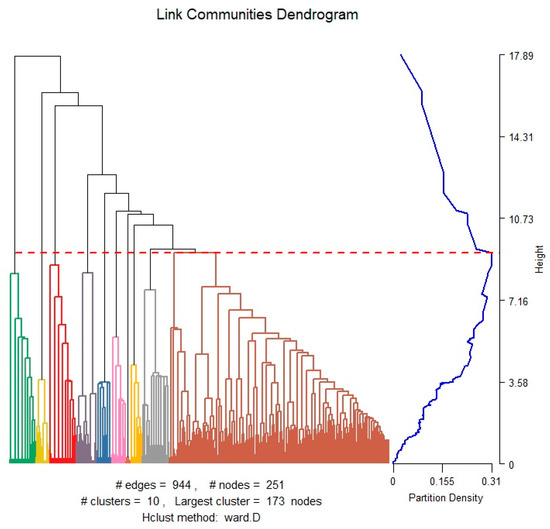
Figure 10.
Dendrogram of network cluster analysis (blue line shows the partition density for different number of clusters. Red dash line shows the number of clusters that produces the maximum partition density. Clusters are distinguished with different colors on the dendogram).
As shown in Figure 10, the highest edge-partition density is in 10 clusters. The posts excluded from the top 1% edges will form the 11th cluster. Each of these clusters represent one of the sub-discussions (communities) in the analyzed posts. The key phrase networks of these 10 sub-discussions are given in Appendix B. As can be seen, the second sub-discussion does not form a contextual network for negative and neutral sentiments. In other words, the context in this sub-discussion is presented in a positive sentiment. Sub-discussions 4, 5, 6, and 7 do not form a contextual network in positive sentiment. Furthermore, the sub-discussions 5, 6, and 7 only form the contextual network in negative sentiment. This shows that the main discussion in these sub-discussions had negative sentiment language. The main topics of the sub-discussions extracted using PDA are given in Table 2 (summary of extracted sub-discussions is presented in Appendix A.2).

Table 2.
Main topics of the sub-discussions extracted using PDA.
As Table 2 and Appendix A.2 show, sub-discussions 5 and 8 are closely related; however, their key phrase network (see Figure A5 and Figure A8) shows that they have different structures in their sentiment. Same goes for sub-discussion 1 and 2; while both are discussing climate change related policies, one of them has more positive sentiment in its contextual structure. Furthermore, Table 2 shows the PDA’s ability to separate the skeptical conversation from concerns and other parts of the conversation. As it shows, sub-discussion 4 is formed based on skepticism and disinformation, and it separates this from the concerns shared in sub-discussion 5 and 8. Sub-discussion 6 shows a metaphorical use of the keywords used for collecting these social media posts.
The topic and summary of sub-discussion 11 shows the small discussions around different topics, which were not popular enough to form a separate sub-discussion. For example, it shows there was conversation around urban planning; however, it was not a large discussion around this topic. The discussions which were popular in the past (e.g., a week earlier) and the discussions that are just being started and have not gained much popularity yet (e.g., they can get a large popularity in the future) will fall into the residual sub-discussion. Figure 11 shows the linkage between the sub-discussions.
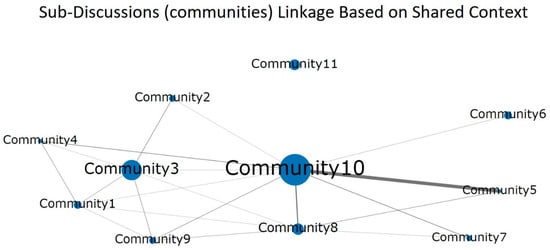
Figure 11.
Network linkage between the sub-discussions.
Concerns Map Results
Using the BTC-LLM algorithm, 3898 concerns were extracted. These concern-topics are categorized into 20 categories. The concern-topic categories are shown in Table 3 (see Appendix A.3 for a summary of concerns in each concern-topic category). The BTC-LLM algorithm were run on 39 batches of concerns, with N = 7 iterations, which after 5th iteration, the list of concern categories remained on change. The LLM model used in this study was the OpenAI’s GPT-3.5 Turbo and it took around 5 h 45 min to produce the results (the call to the LLM was made through REST API).

Table 3.
The concern-topic categories.
Table 3 and Appendix A.3 show the diversity of the topics. The summaries show that the concerns in each category are also connected to other categories. In other words, expressed concerns are linking different concern-topics. The is shown in Figure 12. Furthermore, as Table 3 shows, the concern-topics produced with BTC-LLM have separated and excluded the topics related to the metaphorical use of environment and sustainability keywords.

Figure 12.
Concern-Topic Categories Contextual Network.
The unconnected concern-topic categories in Figure 12 represent the concerns in those categories that were specifically expressed in that one category. However, the connected nodes show the concern-topic categories that share some of the expressed concerns. In other words, if two concern-topic categories are not connected, it does not mean they do not have a rational relation; it means the concerns were not expressed by people in a way that shows that connection. Figure 13 shows the changes in the number of concerns expressed over the studied time period. The low numbers at the beginning and end are due to the fact that not all posts were retrieved on those days, due to technical limitations. As can be seen, some categories of concern were more popular than others, and their popularity changed over time.
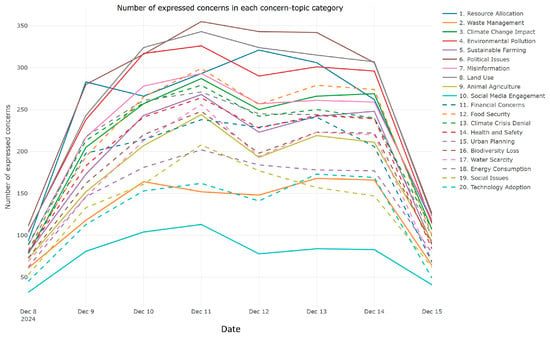
Figure 13.
Popularity trend of concern-topics categories over time.
4. Discussion
Findings from this study show that discussions around sustainability and environmental policies among X users, during the studied period, approached the topic from various angles. From these social media posts, 11 distinct community discussions were identified. Most of these discussions focus on different aspects of eco-friendly farming and promote agriculture’s role in combating climate change.
One of these 11 discussions was shaped by conspiracy theories and misinformation about climate policies. The context of this discussion shows that specific misinformation circulating during this period includes claims that “the climate crisis is a global scam and that reducing the number of humans and cows through farming is the first step in a plan to decrease the human population” and “climate change does not have a serious impact on the environment.” Based on this insight, disseminating information about “how climate change impacts the environment (what is the mechanism of impact)” and “how adapted environmental policies can either address climate change issues or build environmental resilience and contribute to people’s wellbeing” during that period could be effective in combating misinformation about environmental policies and climate change. Another strategy to combat misinformation about environmental policies during that period would be debunking the conspiracy theories around “reducing the human population”.
Among the detected discussions, four focus on the impact of Net-Zero policies on farming and the need to support farmers in implementing climate policies. These discussions reveal public perception of Net-Zero and climate change policies. These insights can help policymakers craft more effective and sustainable climate change policies. For instance, in the discussions, Net-Zero initiatives are considered irrational and harmful due to “closing the land to agriculture and grabbing it”. This insight shows that part of the public seeks justice in Net-Zero initiatives rather than authority-driven approaches. In other words, a successful Net-Zero policy needs to address the fairness of restrictions on farmers’ activities.
Another part of these discussions covers experiences of adapting farming to climate change in different countries. This discussion emphasizes the need to support farmers and criticizes the policing of farmers’ protests. This insight suggests that including supportive measures for transforming farming activities to more sustainable practices should be part of Net-Zero and other climate change policies.
In another discussion, people express their concerns about urban waste management and its environmental impact.
While suggestions from these insights might seem obvious, social intelligence mining methods have provided specific concerns for the specific time period. With more detailed data, it can be directed to specific locations to understand local communities’ concerns. Furthermore, it provides evidence on the priorities for different time periods and regions. For instance, while in one region people might be more concerned about land use and urban planning impacts on farming, in another region, people’s priority might be environmental issues related to waste management in urban areas.
These results illustrate the practical use of the PDA, PCD, and BTC-LLM algorithms in gaining insights from social media posts and using them to craft policies. It should be mentioned that the results are from one week and are limited to English-language posts. In this regard, these results are specific to that period and may change over time. However, the generality of the PDA, PCD, and BTC-LLM algorithms makes it possible to apply them to different periods to obtain updated insights and track changes in public discussion and concerns over time. The application of PDA, PCD, and BTC-LLM across different time periods remains consistent, as the structure of the input data does not change (all methods use social media posts as input). However, tracking trends over time requires additional analysis (see [1,7,8] for details on the methods used to analyze these trends). Furthermore, the performance of PDA, PCD, and BTC-LLM in other languages is sensitive to the NLP models used in various layers (i.e., the key-phrase extraction model, the sentiment analysis model, and the LLM). Therefore, while PDA, PCD, and BTC-LLM can be applied to different languages, the libraries used in each layer may require fine-tuning. It should be noted that the results of this study only demonstrate the practical applicability of BTC-LLM in exploratory topic categorization. However, the accuracy of proposed method in estimating predefined topic labels requires further investigation.
As explained before, the results from social media posts only provide insights from the part of society that is expressing its opinions and concerns on those platforms. While part of the public discussion is being formed and expressed on social media platforms, other parts are circulating in social groups, such as extended families, friendship groups, and other communities. Through interactions between these communities, the part of public discussion that is formed on social media can impact other parts of the public discussion and vice versa. The mechanism and size of these impacts depend on various societal variables, such as age distribution, internet access, social media usage, etc. In this situation, understanding public discussion from social media platforms is necessary but not sufficient to understand the complete structure of public discussions and public concerns. As such, it is important to couple insights from social media platforms with insights from other communities to have a better understanding of public discussions.
The PDA, PCD, and BTC-LLM algorithms are not sensitive to the size of the textual data set (although with a small number of texts, the sub-discussion might not get shaped). Accordingly, these algorithms can be used on specific topics in specific regions, even if the number of social media posts limited to that topic and region is not large. However, it is necessary to be cautious, since in this situation, the results only represent a very small part of the public discussion. As mentioned above, it is crucial to include insights from conventional methods (such as surveys and interviews) to obtain a better understanding, especially in these situations.
5. Conclusions Remarks
Some of the social intelligence mining and contextual analysis methods and their role in land management and planning were reviewed in this study, and a new method, the BTC-LLM algorithm, is proposed for mapping the concerns from social media posts. These methods are applied on a set of posts from the X platform to extract insights related to land use, environmental issues, and climate change from those posts. The results show the ability of the PDA method to distinguish and isolate different aspects of discussion around these topics. For instance, PDA isolated part of the conversation among the X users related to disinformation and conspiracy theories about land use and climate policies while showing there is another sub-discussion that is using these keywords metaphorically to describe their everyday challenges and dispute between celebrities’ fans.
The proposed BTC-LLM algorithm was used to extract the concerns expressed by people and build the concern map. The results show that concerns from a variety of topics were expressed by the people. While in some topics, only concerns in that topic were expressed, some other topics had shared expressed concerns. For example, there were concerns related to both political issues and climate change impact. Furthermore, methods for clustering concepts and how various algorithms can automatically detect and filter out non-relevant text and contributions in social media are explored. In the analyzed data, the method identified and separated the chunk of social media posts that used the topic keywords as metaphors.
The results show that social intelligence mining methods are effectively mapping the public concerns and show the public discussion structure around the land use, urban planning, and related context. These maps can be used by policymakers to craft more effective policies for solving environmental issues while addressing societies’ expectations and concerns. Once public discussions and concerns related to specific urban planning and policies are extracted, land use experts can use these insights to craft the policies and design the plans. For instance, if the expressed concerns and opinions represent a valid issue, experts can adapt the policies and plans to address those issues. If the concerns are not rooted in the reality of adopted policies, policymakers and urban and land use planning experts can use these insights to design more effective community outreach programs to support the adopted policies. It should be noted that by applying social intelligence mining methods to social media posts related to land use and urban planning, the part of the public discussion, concerns, and opinions expressed on these platforms will be extracted. To obtain more detailed insights into public perception on land use planning and policies, these results should be coupled with insights from real-world social network structures (e.g., connectivity between different communities and their exchanges) and insights from parts of society that are usually not represented on social media platforms.
Author Contributions
Conceptualization, M.R.Y., H.H. and N.K.; Methodology, M.R.Y., H.H. and N.K.; Software, M.R.Y.; Formal analysis, H.H. and N.K.; Writing—original draft, M.R.Y., H.H. and N.K.; Writing—review & editing, M.R.Y., H.H. and N.K. All authors have read and agreed to the published version of the manuscript.
Funding
This study was supported partly by the Adaptation AGORA project (grant agreement No. 101093921), MEDiate (grant agreement No. 101074075), and IIASA internal IBGF grant.
Data Availability Statement
The data that support the findings of this study are available from the corresponding author upon reasonable request.
Conflicts of Interest
The authors declare no conflicts of interest.
Appendix A. Summary of the Posts, Sub-Discussions, and Concern Categories
Appendix A.1. Summary of the Posts with Different Sentiment Groups
- Summary of posts with Positive sentiment
The conversation highlights the importance of sustainable farming practices, eco-friendly solutions, and the integration of technology in agriculture. Various topics such as climate-smart agriculture, regenerative agriculture, and the use of innovative methods like AWD irrigation and IoT sensors are discussed. Organizations like Spright Agro Excellence promote green technology and eco-friendly farming practices for a healthier future in agriculture. Livestock farming, waste management, and the benefits of natural seaweed in reducing emissions are also emphasized. The focus is on creating a greener, more sustainable future for agriculture through innovation and technology.
- 2.
- Summary of posts with Neutral sentiment
The conversation covers a range of topics related to climate change, sustainable farming practices, and the impact of agriculture on the environment. It emphasizes the importance of addressing climate change through green infrastructure, renewable energy, and sustainable agriculture. The discussion also touches on the impact of waste, pollution, and land use on the environment. Various initiatives and projects are being implemented to address climate change and promote sustainable agriculture practices, with a focus on reducing waste and combating climate change through eco-friendly farming practices. Initiatives like Net House farming and precision farming are highlighted for their role in enhancing crop yields and reducing waste. The conversation also discusses the integration of biotechnology in agriculture to address pest resistance and climate challenges, emphasizing the need to promote sustainable and humane alternatives to factory farming. Various companies and organizations are working on sustainable agriculture, eco-friendly farming solutions, and climate-resilient agriculture. The conversation highlights the importance of sustainable practices in farming, reducing waste, and combating climate change. Topics include eco-friendly technology, composting, regenerative farming, and the impact of modern agriculture on the environment. Efforts are being made to fight climate change and promote sustainable farming practices in Africa, with a focus on eco-friendly farming practices and sustainable agriculture. The conversation also touches on the importance of soil health, composting, and the role of technology in modern farming practices. Various initiatives are being taken to address climate change, promote sustainable agriculture, and reduce waste. Spright Agro promotes agroforestry, organic farming, and eco-friendly practices to combat climate change and enhance agricultural productivity, with a focus on tailored farming models for different regions to optimize outputs. SAL is dedicated to eco-friendly farming practices, focusing on reducing waste, improving efficiency, and supporting rural development through integrated farming systems that benefit farming and the environment. The conversation also discusses the impact of animal farming on the environment, waste management, and recycling, with a focus on promoting sustainable agriculture and reducing waste. The conversation highlights the positive reception of the government’s new food strategy focusing on food security and sustainable farming, emphasizing the need for innovation and resilience in the agricultural sector to address global challenges. Spright Agro Mission focuses on eco-friendly farming practices, using innovative techniques like Net House farming to improve crop yields, reduce waste, and promote sustainability. The conversation also touches on the importance of indigenous seeds, vertical farming, AI integration in agriculture, and the impact of climate change on farming, with a focus on promoting eco-friendly practices through sustainable agriculture. Various initiatives and projects promoting sustainable farming practices, climate adaptation, and waste reduction are highlighted, with a focus on high-efficiency irrigation systems and climate-resilient farming practices through eco-friendly agriculture. The conversation emphasizes the need for climate-resilient techniques in farming, reducing waste, and promoting eco-friendly practices, with a focus on global food security, carbon farming, and innovative solutions for sustainable agriculture. Spright Agro promotes eco-friendly farming practices through Net House and Greenhouse farming technologies, advocating for climate-smart farming solutions in every region to ensure a brighter future for farming communities. SAL is reshaping the agricultural industry through sustainable farming practices and integrated systems that benefit farming and the environment, focusing on eco-friendly operations and high-value crops to demonstrate a commitment to sustainable agriculture and environmental conservation. The conversation also discusses the importance of promoting eco-friendly farming practices to scale, particularly on American range land, with a focus on sustainable farming, biofuels, and climate-friendly agriculture, as well as waste reduction efforts and the use of AI to predict future landscapes and diverse crops farming for climate resilience.
- 3.
- Summary of posts with Negative sentiment
The conversation covers frustrations with government spending on various projects, accusations of gaslighting, and failure to address real issues like global warming and pollution. Discussions include climate aid, farming, animal agriculture, Brexit’s impact on UK farming, and accusations of wasteful spending. Calls for sustainable farming practices, soil management, and climate action are made.
Appendix A.2. Summary of the Sub-Discussions Extracted Using PDA
Community 1: The conversation covers climate change, sustainable farming, and food security. It discusses the need for resilience, urban planning, and the role of agriculture in combating climate change. Different opinions on causes and solutions are shared. The importance of soil health, biodiversity, and integrating science into land use practices is emphasized. Greenhouse farming, climate-smart agriculture, and conservation agriculture are highlighted as practical solutions.
Community 2: The coalition government is focusing on implementing environment-friendly policies to promote green technology, organic farming, and pollution-free cities to reduce carbon emissions and create a sustainable environment for the future. Organic farming benefits soil health, water conservation, and pollution reduction, supporting sustainable agriculture and environmental preservation. Discussions at COP16Riyadh are centered on innovative pathways to sustainable land use through climate finance and green technology.
Community 3: The conversation covers various topics related to agriculture, climate change, and sustainable farming practices. It emphasizes the need for eco-friendly solutions to combat climate change and support sustainable agriculture. Different perspectives on climate change and farming are shared, highlighting the challenges and complexities in the agricultural sector. Calls for government support for nature-friendly farming and sustainable practices are made.
Community 4: The conversation revolves around the belief that the climate crisis is a global scam and that reducing the number of humans and cows through farming is the first step in a plan to decrease the human population. Some participants express skepticism about climate change and its impact on the environment.
Community 5: The conversation discusses how Net-Zero initiatives are negatively impacting farming by closing land to agriculture or grabbing it, which is seen as irrational and harmful. The conversation criticizes Net-Zero as an expensive and cruel vision pushed by elites, labeling it as a salvation story of climate catastrophism.
Community 6: Participants discussed the challenges of balancing their online and real-world personas, with the online world being idealized as a beautiful garden and the real world seen as a barren wasteland. The conversation highlighted the difficulty of escaping from the pressures and expectations of both worlds, creating a sense of entrapment.
Community 7: Citizens express frustration over high taxes, prices, and poor public services to the Prime Minister. Complaints about overflowing bins and garden waste lead to criticism of local councils. Some residents express dissatisfaction with missed waste collections. Various services, such as garden waste removal and bin collections, are highlighted with schedule changes for the festive period.
Community 8: The conversation discusses the impact of Net-Zero on farming, highlighting concerns about closing land to agriculture and the need to address climate change, pollution, and waste management. SAL champions eco-friendly practices like precision farming and greenhouse technology, leading the way in sustainable agriculture for a greener future.
Community 9: The conversation covers the evolution of rice farming in Vietnam, innovative methods like AWD irrigation, Kitovu’s smart climate farming infrastructure, sustainable practices in Kenya and India, and the policing of farmers’ protests compared to climate activists’. It emphasizes the importance of sustainable farming, better infrastructure, and support for farmers to combat climate change.
Community 10: The conversation emphasizes the importance of sustainable farming practices, climate resilience, and eco-friendly solutions in agriculture. Initiatives by SAL and Spright Agro are highlighted to promote green practices and combat climate change. Collaboration and innovation are seen as crucial in addressing challenges and adapting to future needs for a greener future.
Community 11: Urban planning initiatives focus on eco-friendly transportation, atmospheric deposition, erosion, and climate awareness events. Research on PM 2.5 levels, AI simulations, and noise data collection is ongoing. Two PhDs discuss land use change, pollution, and eco-friendly gardening. The conversation also covers sustainable fashion, waste management, and clean water importance. Michigan cities are proactive in climate change efforts. Organic gardening practices like composting and crop rotation are essential.
Appendix A.3. The Summary of the Concerns in Each Concern-Topic Categories
Concern-Topic Category 1: The concerns delve into a wide range of concerns including government waste, unsustainable farming practices, climate change impacts, and economic challenges. Topics such as lack of transparency, misinformation, and potential threats to food security are discussed. Criticisms are also directed towards policies and initiatives related to agriculture and the environment.
Concern-Topic Category 2: The concerns covered various environmental concerns such as pollution, waste management, climate change, and unsustainable farming practices. Issues included confusion over waste disposal, lack of awareness, inefficient recycling methods, and challenges in implementing sustainable practices. The impact of industrial activities on water pollution, illegal dumping, and the importance of addressing these issues for a healthier environment were emphasized.
Concern-Topic Category 3: The concerns cover a wide range of concerns related to climate change and its impact on farming practices globally. Issues such as food safety, soil degradation, destruction of ecosystems, methane emissions from livestock, lack of awareness about sustainable practices, and the need for eco-friendly farming solutions are discussed. There are also mentions of misinformation, lack of government support, and the importance of collaboration between farmers and policymakers to address the climate crisis.
Concern-Topic Category 4: The concerns delve into environmental concerns such as climate change, pollution, unsustainable farming practices, and the need for sustainable agriculture. Issues like food safety, waste management, and the impact of climate change on farming are discussed, stressing the importance of taking action to protect the environment and ensure food security for future generations.
Concern-Topic Category 5: The concerns address a wide range of environmental concerns related to farming practices, including climate change, pollution, water conservation, and biodiversity loss. There is a strong emphasis on the need for sustainable farming methods to protect the environment and ensure food security for future generations. Challenges faced by farmers worldwide due to climate change are also discussed, highlighting the urgency to address these issues.
Concern-Topic Category 6: The concerns delve into the complexities of farming, climate change, pollution, and resource allocation. Concerns include the environmental impact of agriculture, lack of support for sustainable practices, and challenges faced by farmers. There are discussions on government policies, climate change effects on agriculture, and the need for eco-friendly farming methods to address food security and biodiversity loss.
Concern-Topic Category 7: The concerns address concerns about farming practices, climate change, and environmental impact. Issues such as misinformation, lack of awareness, and negative effects of climate change on agriculture are discussed. The need for sustainable farming methods, eco-friendly practices, and addressing climate change in agriculture is emphasized. Overpopulation and resource scarcity are also mentioned as pressing issues.
Concern-Topic Category 8: The concerns covered various environmental concerns related to farming practices, climate change, pollution, and sustainability. Issues included the negative impact of current farming methods on the environment, challenges faced by farmers, and the need for eco-friendly solutions. Discussions also touched on government policies, land use issues, and the importance of sustainable farming practices.
Concern-Topic Category 9: The concerns focus on the harmful effects of current farming practices on the environment, climate change, and food security. Issues such as pollution, soil degradation, and lack of sustainable methods are discussed, along with concerns about methane emissions from livestock and the need for eco-friendly farming practices to combat these challenges.
Concern-Topic Category 10: The concerns discuss frustrations with farming practices, climate change, and maintaining online personas. There are concerns about misinformation, lack of support for farmers, and the negative impact of engagement farming. Some individuals feel overwhelmed by balancing online and offline identities, while others worry about the disconnect from reality and potential scams in the farming industry.
Concern-Topic Category 11: The concerns highlight various challenges in the farming industry, including climate change impacts, financial struggles, lack of resources, and unsustainable practices. Concerns about food security, environmental consequences, and the need for sustainable farming practices are emphasized. Reforms and support for farmers are seen as essential for the future of agriculture.
Concern-Topic Category 12: The concerns covered a wide range of topics related to farming and its impact on the environment, including concerns about pollution, waste management, food security, climate change, unsustainable practices, and the need for sustainable farming methods. Issues such as soil degradation, water management, income struggles, and lack of climate knowledge were also discussed.
Concern-Topic Category 13: The concerns cover a wide range of topics related to climate change, agriculture, and environmental impact. It includes discussions on the sustainability of current agricultural methods, concerns about misinformation and lack of awareness, and the potential negative effects of climate change on farming and food production. There are also mentions of political decisions, funding allocations, and the role of different sectors in addressing climate change. Overall, the conversation highlights the complexity and urgency of addressing environmental challenges and implementing sustainable practices.
Concern-Topic Category 14: The concerns address a wide range of environmental concerns in farming, including pollution, climate change, soil degradation, and biodiversity loss. It emphasizes the need for sustainable practices, better waste management, and eco-friendly farming methods to mitigate these issues. The impact of climate change on agriculture and the challenges faced by farmers are also highlighted.
Concern-Topic Category 15: The concerns delve into a range of environmental issues such as climate change, pollution, unsustainable farming practices, and urbanization. Concerns include resource allocation, lack of transition to Net-Zero emissions, and the impact of climate change on agriculture and food security. Participants stress the need for sustainable practices, waste management, and eco-friendly solutions to combat these challenges.
Concern-Topic Category 16: The concerns highlight concerns about the negative impact of human activities, such as farming and industrialization, on the environment. Issues like pollution, climate change, and unsustainable practices are discussed. There is a call for more sustainable agriculture practices to protect the environment and ensure food security in the future.
Concern-Topic Category 17: The concerns highlight concerns about the environmental impact of farming practices, including pollution, soil degradation, and climate change effects on food security and water access. Calls for eco-friendly practices, sustainable farming techniques, and better resource management are emphasized to address challenges faced by farmers and protect the environment.
Concern-Topic Category 18: The concerns delve into the impact of human activities on the environment, particularly in farming and waste management. Concerns are raised about pollution, unsustainable practices, and climate change denial. The need for sustainable farming methods, eco-friendly solutions, and addressing environmental issues for future generations is emphasized.
Concern-Topic Category 19: The concerns cover concerns about the impact of climate change on farming, including pollution, lack of sustainability, and exploitation of traditional practices. It also discusses issues such as food insecurity, unequal wealth distribution, and the negative effects of farming practices on the environment. Additionally, social issues like racism and rural stress are mentioned.
Concern-Topic Category 20: The concerns highlighted various challenges in agriculture, including lack of information on sustainable farming, soil degradation, climate change’s impact on food security, and resistance to eco-friendly policies. Concerns about traditional farming practices, lack of awareness about sustainable methods, and the need for climate-smart agriculture were discussed. Calls for improved farming techniques, balanced fertilization, and sustainable practices to address these challenges were made.
Appendix B. Key Phrase Network of 10 Sub-Discussions, Categorized by Sentiment

Figure A1.
Key phrase network of sub-discussion 1.
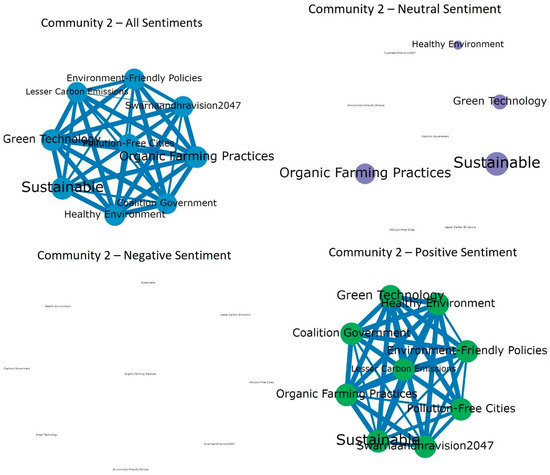
Figure A2.
Key phrase network of sub-discussion 2.

Figure A3.
Key phrase network of sub-discussion 3.

Figure A4.
Key phrase network of sub-discussion 4.

Figure A5.
Key phrase network of sub-discussion 5.
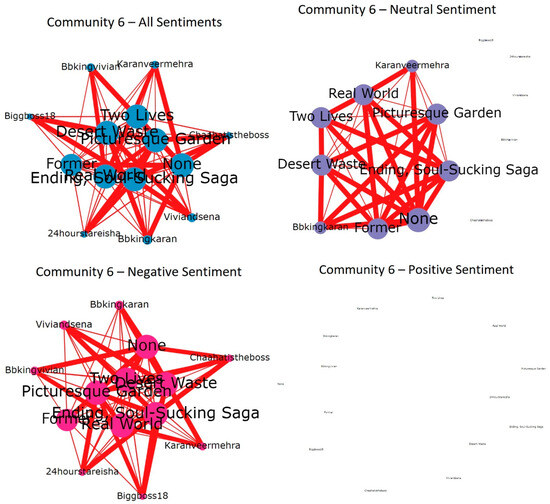
Figure A6.
Key phrase network of sub-discussion 6.
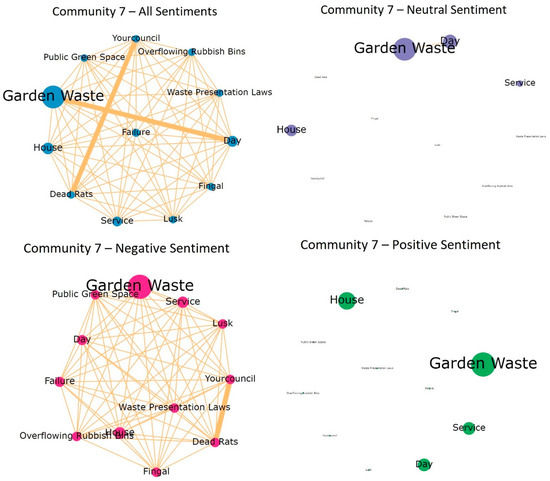
Figure A7.
Key phrase network of sub-discussion 7.

Figure A8.
Key phrase network of sub-discussion 8.
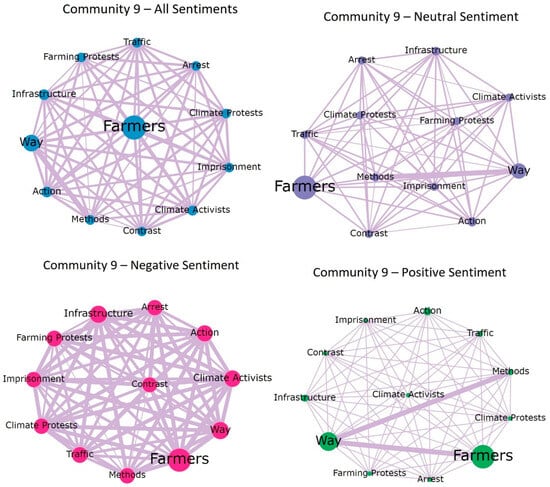
Figure A9.
Key phrase network of sub-discussion 9.
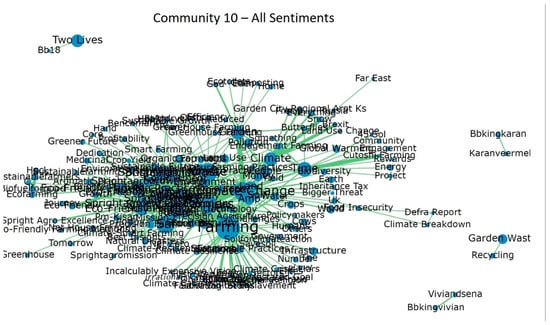
Figure A10.
Key phrase network of sub-discussion 10 (all sentiments).
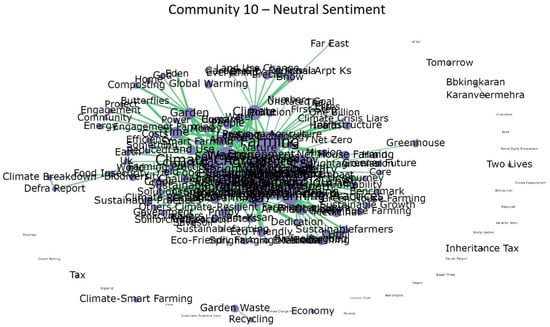
Figure A11.
Key phrase network of sub-discussion 10 (Neutral sentiment).
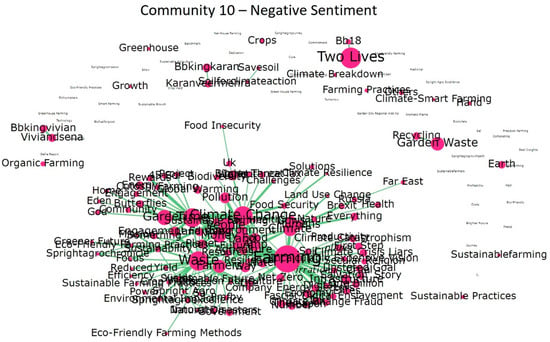
Figure A12.
Key phrase network of sub-discussion 10 (Negative sentiment).

Figure A13.
Key phrase network of sub-discussion 10 (Positive sentiment).
References
- Komendantova, N.; Hassani, H.; Yeganegi, M.R.; Al Salaymeh, A.; Qoaider, L. Navigating the Currents: Land Use Challenges Amidst Water and Food Security Debates and Social Media Misperceptions. Land 2024, 13, 1525. [Google Scholar] [CrossRef]
- Danilina, N.; Korobeinikova, A.; Teplova, I. Decision-Making Approach for Land Use in Urban Industrial Area Redevelopment Projects. Sustainability 2024, 16, 9827. [Google Scholar] [CrossRef]
- Wagner, M.; de Vries, W.T. Comparative Review of Methods Supporting Decision-Making in Urban Development and Land Management. Land 2019, 8, 123. [Google Scholar] [CrossRef]
- Miyake, Y.; Nakagawa, Y.; Uchiyama, Y.; Takatori, C.; Kohsaka, R. Decision Dynamics and Landscape Approach by Individuals and Collective Groups: The Case of Japanese Rural Land Use in Agricultural, Forest, and Boundary Areas in an Era of Population Decline. Discov. Sustain. 2024, 5, 281. [Google Scholar] [CrossRef]
- Alhassan, A.Y. Rethinking Participation in Urban Planning: Analytical and Practical Contributions of Social Network Analysis. Front. Urban Rural Plan. 2025, 3, 1. [Google Scholar] [CrossRef]
- Qi, J.; Mazumdar, S.; Vasconcelos, A.C. Understanding the Relationship between Urban Public Space and Social Cohesion: A Systematic Review. Int. J. Community Well-Being 2024, 7, 155–212. [Google Scholar] [CrossRef]
- Hassani, H.; Komendantova, N.; Rovenskaya, E.; Yeganegi, M.R. Unveiling the Waves of Mis- and Disinformation from Social Media. Int. J. Model. Simul. Sci. Comput. 2024, 15, 2450033. [Google Scholar] [CrossRef]
- Hassani, H.; Komendantova, N.; Rovenskaya, E.; Yeganegi, M.R. Social Intelligence Mining: Unlocking Insights from X. Mach. Learn. Knowl. Extr. 2023, 5, 1921–1936. [Google Scholar] [CrossRef]
- Li, I.; Pan, J.; Goldwasser, J.; Verma, N.; Wong, W.P.; Nuzumlalı, M.Y.; Rosand, B.; Li, Y.; Zhang, M.; Chang, D.; et al. Neural Natural Language Processing for Unstructured Data in Electronic Health Records: A Review. Comput. Sci. Rev. 2022, 46, 100511. [Google Scholar] [CrossRef]
- Mahadevkar, S.V.; Patil, S.; Kotecha, K.; Soong, L.W.; Choudhury, T. Exploring AI-Driven Approaches for Unstructured Document Analysis and Future Horizons. J. Big Data 2024, 11, 92. [Google Scholar] [CrossRef]
- Zaoui Seghroucheni, O.; Lazaar, M.; Al Achhab, M. Using AI and NLP for Tacit Knowledge Conversion in Knowledge Management Systems: A Comparative Analysis. Technologies 2025, 13, 87. [Google Scholar] [CrossRef]
- Ayadi, Y.; Gentilucci, M.; Ncibi, K.; Hadji, R.; Hamed, Y. Assessment of a Groundwater Potential Zone Using Geospatial Artificial Intelligence (Geo-AI), Remote Sensing (RS), and GIS Tools in Majerda Transboundary Basin (North Africa). Water 2025, 17, 331. [Google Scholar] [CrossRef]
- Khan, A.A.; Xue, X.; Hussain, H.; Hussain, K.; Muhammad, A.; Mukhtar, M.A.; Butt, A.Q. Study of Land Surface Changes in Highland Environments for the Sustainable Management of the Mountainous Region in Gilgit-Baltistan, Pakistan. Sustainability 2024, 16, 311. [Google Scholar] [CrossRef]
- Ahmed, R.; Zafor, M.A.; Trachte, K. Land-Use and Land-Cover Changes in Cottbus City and Spree-Neisse District, Germany, in the Last Two Decades: A Study Using Remote Sensing Data and Google Earth Engine. Remote Sens. 2024, 16, 2773. [Google Scholar] [CrossRef]
- Assimakopoulos, F.; Vassilakis, C.; Margaris, D.; Kotis, K.; Spiliotopoulos, D. Artificial Intelligence Tools for the Agriculture Value Chain: Status and Prospects. Electronics 2024, 13, 4362. [Google Scholar] [CrossRef]
- Lv, S.; Xia, X.; Chen, Q.; Pan, Y. Quality Evaluation of Multi-Source Cropland Data in Alpine Agricultural Areas of the Qinghai-Tibet Plateau. Remote Sens. 2024, 16, 3611. [Google Scholar] [CrossRef]
- Sadenova, M.; Beisekenov, N.; Varbanov, P.S. Assessing the Effectiveness of RS, GIS, and AI Data Integration in Analysing Agriculture Performance to Enable Sustainable Land Management. Discov. Sustain. 2024, 5, 478. [Google Scholar] [CrossRef]
- Maceika, A.; Bugajev, A.; Šostak, O.R. Enhancing Organizational Resilience: Sustainable Development Scenarios Incorporating Disaster Impacts and AI Tools. Sustainability 2024, 16, 11147. [Google Scholar] [CrossRef]
- McKee, A.; Beingessner, N. A Literature Review of the Social and Economic Impacts of Land Use Change; The James Hutton Institute: Craigiebuckler Aberdeen, UK, 2023. [Google Scholar] [CrossRef]
- Karimi, A.; Hockings, M. A Social-Ecological Approach to Land-Use Conflict to Inform Regional and Conservation Planning and Management. Landsc. Ecol. 2018, 33, 691–710. [Google Scholar] [CrossRef]
- Tessema, M.W.; Abebe, B.G. Public Perception on the Role of Urban Green Infrastructure Development and Land Use Management in Rapidly Urbanized Countries: The Case of Hawassa City, Ethiopia. Fudan J. Humanit. Soc. Sci. 2024, 17, 73–113. [Google Scholar] [CrossRef]
- Lin, Y.; Geertman, S. Can Social Media Play a Role in Urban Planning? A Literature Review. In Computational Urban Planning and Management for Smart Cities; Geertman, S., Zhan, Q., Allan, A., Pettit, C., Eds.; Springer International Publishing: Cham, Switzerland, 2019; pp. 69–84. ISBN 978-3-030-19424-6. [Google Scholar]
- Naja, I.; Valdez, M.; Antonini, A. Social Media and Cities: A Case-Study Based Analysis of How Digital Life Influences the Urban Physical Environment. In Proceedings of the 35th ACM Conference on Hypertext and Social Media, Poznan, Poland, 10–13 September 2024; Association for Computing Machinery: New York, NY, USA, 2024; pp. 239–245. [Google Scholar]
- Gilg, A. Perceptions about Land Use. Land Use Policy 2009, 26, S76–S82. [Google Scholar] [CrossRef]
- Rösch, C.; Fakharizadehshirazi, E. Public Participation GIS Scenarios for Decision-Making on Land-Use Requirements for Renewable Energy Systems. Energy Sustain. Soc. 2025, 15, 18. [Google Scholar] [CrossRef]
- Atiqul Haq, S.M.; Islam, M.N.; Siddhanta, A.; Ahmed, K.J.; Chowdhury, M.T.A. Public Perceptions of Urban Green Spaces: Convergences and Divergences. Front. Sustain. Cities 2021, 3, 755313. [Google Scholar] [CrossRef]
- Qu, Z.; Lu, Y.; Jiang, Z.; Bassett, E.; Tan, T. A Psychological Approach to ‘Public Perception’ of Land-Use Planning: A Case Study of Jiangsu Province, China. Sustainability 2018, 10, 3056. [Google Scholar] [CrossRef]
- Zhang, Y.; Chen, F.; Rohe, K. Social Media Public Opinion as Flocks in a Murmuration: Conceptualizing and Measuring Opinion Expression on Social Media. J. Comput.-Mediat. Commun. 2022, 27, zmab021. [Google Scholar] [CrossRef]
- Shahbazi, M.; Bunker, D. Social Media Trust: Fighting Misinformation in the Time of Crisis. Int. J. Inf. Manag. 2024, 77, 102780. [Google Scholar] [CrossRef]
- Glazier, R.A.; Topping, M.P. Using Social Media to Advance Community-Based Research. PS Political Sci. Politics 2021, 54, 254–258. [Google Scholar] [CrossRef]
- Liao, H.; Wang, C.; Gu, Y.; Liu, R. A Text Data Mining-Based Digital Transformation Opinion Thematic System for Online Social Media Platforms. Systems 2025, 13, 159. [Google Scholar] [CrossRef]
- Grootendorst, M.R. BERTopic: Neural Topic Modeling with a Class-Based TF-IDF Procedure. arXiv 2022, arXiv:2203.05794. [Google Scholar] [CrossRef]
- Devlin, J.; Chang, M.-W.; Lee, K.; Toutanova, K. BERT: Pre-Training of Deep Bidirectional Transformers for Language Understanding. arXiv 2019, arXiv:1810.04805. [Google Scholar] [CrossRef]
- Lan, Z.; Chen, M.; Goodman, S.; Gimpel, K.; Sharma, P.; Soricut, R. ALBERT: A Lite BERT for Self-Supervised Learning of Language Representations. arXiv 2019, arXiv:1909.11942. [Google Scholar] [CrossRef]
- Pennington, J.; Socher, R.; Manning, C. GloVe: Global Vectors for Word Representation. In Proceedings of the 2014 Conference on Empirical Methods in Natural Language Processing (EMNLP), Doha, Qatar, 25–29 October 2014; Moschitti, A., Pang, B., Daelemans, W., Eds.; Association for Computational Linguistics: Kerrville, TX, USA, 2014; pp. 1532–1543. [Google Scholar]
Disclaimer/Publisher’s Note: The statements, opinions and data contained in all publications are solely those of the individual author(s) and contributor(s) and not of MDPI and/or the editor(s). MDPI and/or the editor(s) disclaim responsibility for any injury to people or property resulting from any ideas, methods, instructions or products referred to in the content. |
© 2025 by the authors. Licensee MDPI, Basel, Switzerland. This article is an open access article distributed under the terms and conditions of the Creative Commons Attribution (CC BY) license (https://creativecommons.org/licenses/by/4.0/).